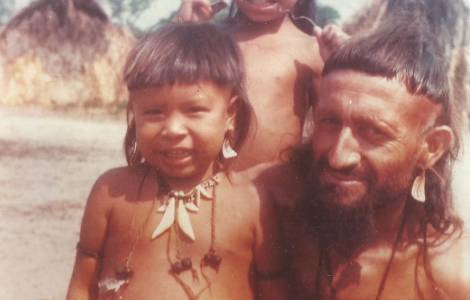
Cuiabá (Agenzia Fides) - "Kiwxí" was the Indian name of Jesuit missionary Vicente Cañas, who together with his confrere Fr. Thomaz Aquino Lisbôa made the first contacts with the indigenous peoples living in the northwest of Mato Grosso (Brazil) in the 1970s. For more than a decade, Kiwxí lived with several indigenous peoples (Tapayuna Indians, Paresi, Mÿky and Enawene Nawe), sharing their customs and traditions, defending indigenous lands from landowners who wanted to take away their lands and fought with the Brazilian government to establish an official demarcation, which was achieved after his violent death. These missionaries were the founders of the Brazilian Indigenous Missionary Council (CIMI) and members of the Anchieta operation (OPAN).
According to the information sent to Agenzia Fides, Vicente Cañas was born in Albacete, Spain on October 22, 1939. At the age of 21, he entered the novitiate of the Society of Jesus, where he matured his missionary vocation. On the feast of Saint Francis Saverio in 1965 he received the missionary cross and on January 19, 1966, he arrived in Brazil. In 1968 his new destination, Mato Grosso, where he committed himself wholeheartedly in the inculturation of indigenous peoples. Gradually he became one of them, he participated in their rituals, fishing, at work, in the creation of objects and handicrafts. He learned their language and wrote a diary of over 3,000 pages with great anthropological value, where one understands his attention towards small things and where he also wrote the death threats he was facing.
He built a hut on the Juruena River, about 60km from the village of Enawene Nawe, where he occasionally went to listen to classical music, reorganize his thoughts. He also spent his periods of illness there, so as not to infect anyone in the village, and left his clothes and dressed like an Indian. In 1974 there were only 97 Indigenous Enawene Nawe, today there are a thousand, also thanks to the work of this missionary.
Vicente Cañas was martyred at 48 years of age, in April 1987. Among the signs of violent homicide: the overturned hut, broken glasses and teeth, wounds to the skull a perforation at the top of his abdomen. His body was found 40 days later. On the morning of May 22 he was buried according to the habits of the Indians, in the presence of many representatives of indigenous peoples, Enawene Nawe, Rikbaktsa and Myky, together with several missionaries and lay persons.
The first trial on his case was only celebrated in 2006, 19 years after the crime, and the accused were acquitted for lack of evidence. On November 29, a new trial will be held in Cuiabá (Brazil), to judge the only accused survivor, Ronaldo Antônio Osmar, accused of participating in the crime.
The cause of "Kiwxí" draws our attention to those who still today defend the human rights of indigenous peoples with their lives and the need to preserve the Amazon. (SL) (Agenzia Fides, 14/11/2017)